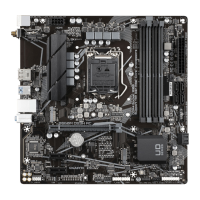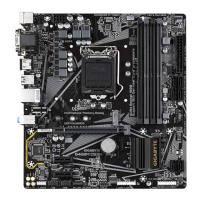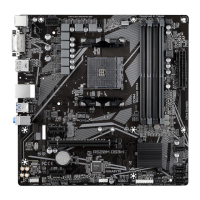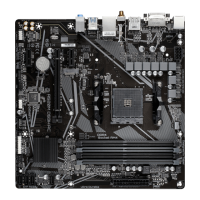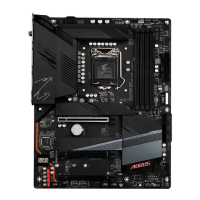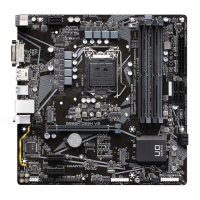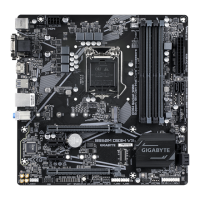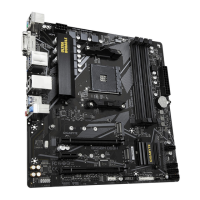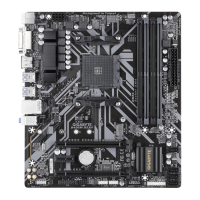Do you have a question about the Gigabyte B560 DS3H AC and is the answer not in the manual?
Lists the items included in the motherboard package for reference.
Safety guidelines and procedures to follow before installing the motherboard and hardware.
Details on CPU, Chipset, Memory, Graphics, Audio, LAN, and Wireless.
Details on PCI Express slots, including their types and configurations.
Specifications for M.2 connectors and SATA 6Gb/s connectors.
Information on USB Type-C and USB 3.2 Gen 1 ports.
List and description of various internal connectors on the motherboard.
Step-by-step guide and precautions for installing the CPU on the motherboard.
Instructions and guidelines for installing memory modules, including dual channel.
Explains how to configure memory for dual channel performance.
Guidelines for installing expansion cards into PCIe slots.
Detailed description of each back panel connector.
Information about USB 3.2 Gen 1 ports for faster data transfer.
Details on the reversible USB Type-C port.
Explanation of the Gigabit Ethernet LAN port and its LEDs.
Instructions for connecting antennas for wireless communication.
Description of the audio jack for line-in devices.
Description of the audio jack for front speaker output.
Description of the audio jack for microphone and center/subwoofer output.
Description of the audio jack for front panel line out.
Table showing audio jack functionality for different channel configurations.
Identifies and lists various internal connectors on the motherboard.
Detailed pinout and function of ATX 12V and main power connectors.
Explanation of 4-pin fan headers, speed control, and current limits.
Details on connecting addressable LED strips and pin assignments.
Details on connecting RGB LED strips and pin assignments.
Information on using the Q-Flash Plus button for BIOS updates without CPU.
Details on SATA connectors, speeds, and pin assignments.
Instructions for installing M.2 SSDs into the M.2 connectors.
Pin assignments for connecting front panel components like power and reset switches.
Pin assignments for connecting the chassis front panel audio module.
Pin assignments for the USB Type-C header.
Pin assignments for the USB 3.2 Gen 1 header.
Pin assignments for USB 2.0/1.1 headers.
Pin assignments for connecting a Trusted Platform Module.
Instructions on how to clear CMOS values using the jumper.
Information about the CMOS battery and its replacement.
Describes the initial logo screen displayed during system startup.
Overview of the Main Menu in BIOS setup, including navigation and function keys.
Details on configuring fan speed control and monitoring temperatures.
How to set and use favorite BIOS settings for quick access.
Section for performance tuning, overclocking, and advanced CPU settings.
Allows adjustment of the CPU clock ratio for performance tuning.
Allows setting the CPU Uncore ratio for performance tuning.
Allows setting the Graphics Ratio for performance tuning.
Various advanced settings for CPU performance and features.
Allows selection of the number of active CPU cores.
Enables or disables Intel Speed Shift Technology for faster frequency ramping.
Enables or disables CPU overheating protection.
Allows adjustment of the CPU Ring ratio auto-down function.
Enables or disables Enhanced Intel Speed Step Technology for power saving.
Enables or disables CPU power saving related settings.
Allows enabling or disabling Intel Turbo Boost Technology.
Enables or disables Intel Turbo Boost Max Technology 3.0 for performance optimization.
Enables or disables CPU Flex Ratio for clock ratio adjustment.
Allows setting the CPU Flex Ratio.
Allows enabling/disabling automatic CPU frequency reduction by TVB.
Allows enabling/disabling automatic CPU voltage reduction by TVB.
Allows setting CPU Turbo ratios for active cores.
Allows controlling each CPU core limit separately.
Manages CPU power saving states (C1E, C3, C6/C7, C8, C10).
Specifies the C-state limit for the processor.
Allows increasing CPU performance.
Allows setting power limits for CPU Turbo mode.
Allows setting power limit and time for Turbo mode.
Allows setting current limit for CPU Turbo mode.
Enables reading SPD data on XMP modules for enhanced memory performance.
Allows setting the system memory multiplier based on SPD data.
Allows manual adjustment of the memory reference clock.
Enables Qclk to run in odd frequency.
Allows improving maximum OC frequency potential.
Submenu for advanced memory configuration and tuning.
Provides different levels of memory auto-tuning.
Enables or disables memory channel interleaving for performance.
Enables or disables memory rank interleaving for performance.
Provides memory detection and training methods.
Allows fine-tuning memory timings after BIOS stage.
Provides various memory performance enhancement settings.
Displays information on the installed memory.
Covers standard, advanced, and miscellaneous timing controls for memory.
Allows adjustment of CPU Vcore and memory voltages.
Configures Load-Line Calibration, over-voltage, and over-current protection.
Section for various system configuration settings.
Manages power states like ASPM for devices.
Allows system power-on via keyboard input.
Sets a password to prevent unauthorized system startup.
Allows system power-on via mouse input.
Controls system power consumption in S5 shutdown state.
Configures the power button behavior for system shutdown.
Allows setting a scheduled time for the system to power on.
Enables or disables dummy load for power supply stability.
Allows onboard graphics to enter standby mode for power saving.
Determines system state after AC power restoration.
Configuration for onboard I/O ports.
Sets the primary display device (onboard graphics or PCIe slot).
Enables or disables the onboard graphics function.
Sets the memory size allocated to onboard graphics.
Allocates DVMT memory size for onboard graphics.
Sets maximum system memory for graphics card allocation.
Enables or disables the onboard LAN function.
Enables or disables the onboard audio function.
Enables decoding of devices in above 4GB address space.
Enables or disables IOAPIC entries.
Settings related to USB functionality and devices.
Allows USB keyboard/mouse use in MS-DOS.
Enables XHCI Hand-off for OS without XHCI support.
Enables or disables support for USB storage devices.
Displays connected USB mass storage devices.
Settings for network booting and configuration.
Enables or disables booting from the network.
Enables or disables IPv4 PXE boot support.
Enables or disables IPv4 HTTP boot support.
Enables or disables IPv6 PXE boot support.
Enables or disables IPv6 HTTP boot support.
Configures wait time for PXE boot.
Sets the number of times to check media presence.
Displays information on M.2 NVMe PCIe SSDs.
Configuration for SATA controllers and Intel RST.
Enables or disables integrated SATA controllers.
Selects SATA mode (Intel RST Premium or AHCI).
Enables or disables power saving feature for SATA controllers.
Enables or disables individual SATA ports.
Allows SATA devices to enter sleep mode.
Enables or disables hot plug capability for SATA ports.
Enables or disables support for external SATA devices.
Information on LAN configuration options.
Various miscellaneous settings.
Sets the LED lighting mode for the motherboard.
Controls motherboard LED lighting in power-saving states.
Enables or disables Intel PTT Technology.
Allows enhancement of legacy benchmark performance.
Sets the PCIe link speed for CPU-controlled slots.
Sets the PCIe link speed for Chipset-controlled slots.
Enables or disables Intel Virtualization Technology for Directed I/O.
Enables or disables Trusted Platform Module (TPM).
Displays system health information and voltages.
Resets the record of previous chassis intrusion status.
Displays chassis intrusion detection status.
Displays current system voltages.
Provides information on motherboard model, BIOS version, and system details.
Displays current access level based on password protection.
Selects the default language used by the BIOS.
Sets the system date.
Sets the system time.
Displays information on PCI Express and M.2 devices.
Accesses the Q-Flash utility for BIOS updates.
Configuration settings related to system boot order and options.
Enables or disables Numlock on the numeric keypad after POST.
Enables or disables the MSR 0xE2 function.
Specifies password requirements for system boot or BIOS setup.
Determines whether to display the GIGABYTE Logo at startup.
Specifies the overall boot order from available devices.
Enables or disables Fast Boot to shorten OS boot process.
Selects the operating system boot type (Legacy or EFI).
Controls USB device functionality during boot.
Controls PS/2 device functionality during boot.
Enables or disables network booting.
Determines system behavior after AC power restoration.
Sets the mouse cursor movement speed.
Selects the operating system to be installed.
Enables or disables UEFI CSM for legacy PC boot process.
Enables or disables legacy option ROM for LAN controller.
Controls UEFI or legacy option ROM for storage controllers.
Controls UEFI or Legacy option ROM for other PCI devices.
Allows configuration of an administrator password for BIOS settings.
Allows configuration of a user password for limited BIOS access.
Enables or disables Secure Boot and configures related settings.
Selects the default BIOS entry mode (Easy or Advanced).
Options for saving BIOS changes, exiting, and loading defaults.
Saves current BIOS settings and exits the setup program.
Exits BIOS setup without saving any changes.
Loads the optimal BIOS default settings.
Selects a device to boot immediately.
Saves current BIOS settings to a profile.
Loads previously saved BIOS settings from a profile.
Steps to install and enable Intel Optane Memory for storage acceleration.
Steps for installing motherboard drivers from the included disc.
Lists the items included in the motherboard package for reference.
Safety guidelines and procedures to follow before installing the motherboard and hardware.
Details on CPU, Chipset, Memory, Graphics, Audio, LAN, and Wireless.
Details on PCI Express slots, including their types and configurations.
Specifications for M.2 connectors and SATA 6Gb/s connectors.
Information on USB Type-C and USB 3.2 Gen 1 ports.
List and description of various internal connectors on the motherboard.
Step-by-step guide and precautions for installing the CPU on the motherboard.
Instructions and guidelines for installing memory modules, including dual channel.
Explains how to configure memory for dual channel performance.
Guidelines for installing expansion cards into PCIe slots.
Detailed description of each back panel connector.
Information about USB 3.2 Gen 1 ports for faster data transfer.
Details on the reversible USB Type-C port.
Explanation of the Gigabit Ethernet LAN port and its LEDs.
Instructions for connecting antennas for wireless communication.
Description of the audio jack for line-in devices.
Description of the audio jack for front speaker output.
Description of the audio jack for microphone and center/subwoofer output.
Description of the audio jack for front panel line out.
Table showing audio jack functionality for different channel configurations.
Identifies and lists various internal connectors on the motherboard.
Detailed pinout and function of ATX 12V and main power connectors.
Explanation of 4-pin fan headers, speed control, and current limits.
Details on connecting addressable LED strips and pin assignments.
Details on connecting RGB LED strips and pin assignments.
Information on using the Q-Flash Plus button for BIOS updates without CPU.
Details on SATA connectors, speeds, and pin assignments.
Instructions for installing M.2 SSDs into the M.2 connectors.
Pin assignments for connecting front panel components like power and reset switches.
Pin assignments for connecting the chassis front panel audio module.
Pin assignments for the USB Type-C header.
Pin assignments for the USB 3.2 Gen 1 header.
Pin assignments for USB 2.0/1.1 headers.
Pin assignments for connecting a Trusted Platform Module.
Instructions on how to clear CMOS values using the jumper.
Information about the CMOS battery and its replacement.
Describes the initial logo screen displayed during system startup.
Overview of the Main Menu in BIOS setup, including navigation and function keys.
Details on configuring fan speed control and monitoring temperatures.
How to set and use favorite BIOS settings for quick access.
Section for performance tuning, overclocking, and advanced CPU settings.
Allows adjustment of the CPU clock ratio for performance tuning.
Allows setting the CPU Uncore ratio for performance tuning.
Allows setting the Graphics Ratio for performance tuning.
Various advanced settings for CPU performance and features.
Allows selection of the number of active CPU cores.
Enables or disables Intel Speed Shift Technology for faster frequency ramping.
Enables or disables CPU overheating protection.
Allows adjustment of the CPU Ring ratio auto-down function.
Enables or disables Enhanced Intel Speed Step Technology for power saving.
Enables or disables CPU power saving related settings.
Allows enabling or disabling Intel Turbo Boost Technology.
Enables or disables Intel Turbo Boost Max Technology 3.0 for performance optimization.
Enables or disables CPU Flex Ratio for clock ratio adjustment.
Allows setting the CPU Flex Ratio.
Allows enabling/disabling automatic CPU frequency reduction by TVB.
Allows enabling/disabling automatic CPU voltage reduction by TVB.
Allows setting CPU Turbo ratios for active cores.
Allows controlling each CPU core limit separately.
Manages CPU power saving states (C1E, C3, C6/C7, C8, C10).
Specifies the C-state limit for the processor.
Allows increasing CPU performance.
Allows setting power limits for CPU Turbo mode.
Allows setting power limit and time for Turbo mode.
Allows setting current limit for CPU Turbo mode.
Enables reading SPD data on XMP modules for enhanced memory performance.
Allows setting the system memory multiplier based on SPD data.
Allows manual adjustment of the memory reference clock.
Enables Qclk to run in odd frequency.
Allows improving maximum OC frequency potential.
Submenu for advanced memory configuration and tuning.
Provides different levels of memory auto-tuning.
Enables or disables memory channel interleaving for performance.
Enables or disables memory rank interleaving for performance.
Provides memory detection and training methods.
Allows fine-tuning memory timings after BIOS stage.
Provides various memory performance enhancement settings.
Displays information on the installed memory.
Covers standard, advanced, and miscellaneous timing controls for memory.
Allows adjustment of CPU Vcore and memory voltages.
Configures Load-Line Calibration, over-voltage, and over-current protection.
Section for various system configuration settings.
Manages power states like ASPM for devices.
Allows system power-on via keyboard input.
Sets a password to prevent unauthorized system startup.
Allows system power-on via mouse input.
Controls system power consumption in S5 shutdown state.
Configures the power button behavior for system shutdown.
Allows setting a scheduled time for the system to power on.
Enables or disables dummy load for power supply stability.
Allows onboard graphics to enter standby mode for power saving.
Determines system state after AC power restoration.
Configuration for onboard I/O ports.
Sets the primary display device (onboard graphics or PCIe slot).
Enables or disables the onboard graphics function.
Sets the memory size allocated to onboard graphics.
Allocates DVMT memory size for onboard graphics.
Sets maximum system memory for graphics card allocation.
Enables or disables the onboard LAN function.
Enables or disables the onboard audio function.
Enables decoding of devices in above 4GB address space.
Enables or disables IOAPIC entries.
Settings related to USB functionality and devices.
Allows USB keyboard/mouse use in MS-DOS.
Enables XHCI Hand-off for OS without XHCI support.
Enables or disables support for USB storage devices.
Displays connected USB mass storage devices.
Settings for network booting and configuration.
Enables or disables booting from the network.
Enables or disables IPv4 PXE boot support.
Enables or disables IPv4 HTTP boot support.
Enables or disables IPv6 PXE boot support.
Enables or disables IPv6 HTTP boot support.
Configures wait time for PXE boot.
Sets the number of times to check media presence.
Displays information on M.2 NVMe PCIe SSDs.
Configuration for SATA controllers and Intel RST.
Enables or disables integrated SATA controllers.
Selects SATA mode (Intel RST Premium or AHCI).
Enables or disables power saving feature for SATA controllers.
Enables or disables individual SATA ports.
Allows SATA devices to enter sleep mode.
Enables or disables hot plug capability for SATA ports.
Enables or disables support for external SATA devices.
Information on LAN configuration options.
Various miscellaneous settings.
Sets the LED lighting mode for the motherboard.
Controls motherboard LED lighting in power-saving states.
Enables or disables Intel PTT Technology.
Allows enhancement of legacy benchmark performance.
Sets the PCIe link speed for CPU-controlled slots.
Sets the PCIe link speed for Chipset-controlled slots.
Enables or disables Intel Virtualization Technology for Directed I/O.
Enables or disables Trusted Platform Module (TPM).
Displays system health information and voltages.
Resets the record of previous chassis intrusion status.
Displays chassis intrusion detection status.
Displays current system voltages.
Provides information on motherboard model, BIOS version, and system details.
Displays current access level based on password protection.
Selects the default language used by the BIOS.
Sets the system date.
Sets the system time.
Displays information on PCI Express and M.2 devices.
Accesses the Q-Flash utility for BIOS updates.
Configuration settings related to system boot order and options.
Enables or disables Numlock on the numeric keypad after POST.
Enables or disables the MSR 0xE2 function.
Specifies password requirements for system boot or BIOS setup.
Determines whether to display the GIGABYTE Logo at startup.
Specifies the overall boot order from available devices.
Enables or disables Fast Boot to shorten OS boot process.
Selects the operating system boot type (Legacy or EFI).
Controls USB device functionality during boot.
Controls PS/2 device functionality during boot.
Enables or disables network booting.
Determines system behavior after AC power restoration.
Sets the mouse cursor movement speed.
Selects the operating system to be installed.
Enables or disables UEFI CSM for legacy PC boot process.
Enables or disables legacy option ROM for LAN controller.
Controls UEFI or legacy option ROM for storage controllers.
Controls UEFI or Legacy option ROM for other PCI devices.
Allows configuration of an administrator password for BIOS settings.
Allows configuration of a user password for limited BIOS access.
Enables or disables Secure Boot and configures related settings.
Selects the default BIOS entry mode (Easy or Advanced).
Options for saving BIOS changes, exiting, and loading defaults.
Saves current BIOS settings and exits the setup program.
Exits BIOS setup without saving any changes.
Loads the optimal BIOS default settings.
Selects a device to boot immediately.
Saves current BIOS settings to a profile.
Loads previously saved BIOS settings from a profile.
Steps to install and enable Intel Optane Memory for storage acceleration.
Steps for installing motherboard drivers from the included disc.
| Chipset | Intel B560 |
|---|---|
| Form Factor | ATX |
| Socket | LGA 1200 |
| Memory Type | DDR4 |
| Memory Slots | 4 |
| Maximum Memory | 128GB |
| PCIe x1 Slots | 2 |
| M.2 Slots | 2 |
| SATA Ports | 6 |
| Audio | Realtek ALC897 |
| Bluetooth | Bluetooth 5.1 |
| USB Ports | USB 3.2 Gen 1, USB 2.0 |
| Video Outputs | HDMI, DisplayPort |
| LAN | Realtek GbE LAN |
| Wireless | Intel Wi-Fi 6 |
| PCIe x16 Slots | 1 x PCIe 4.0 x16, 1 x PCIe 3.0 x16 (x4 mode) |
